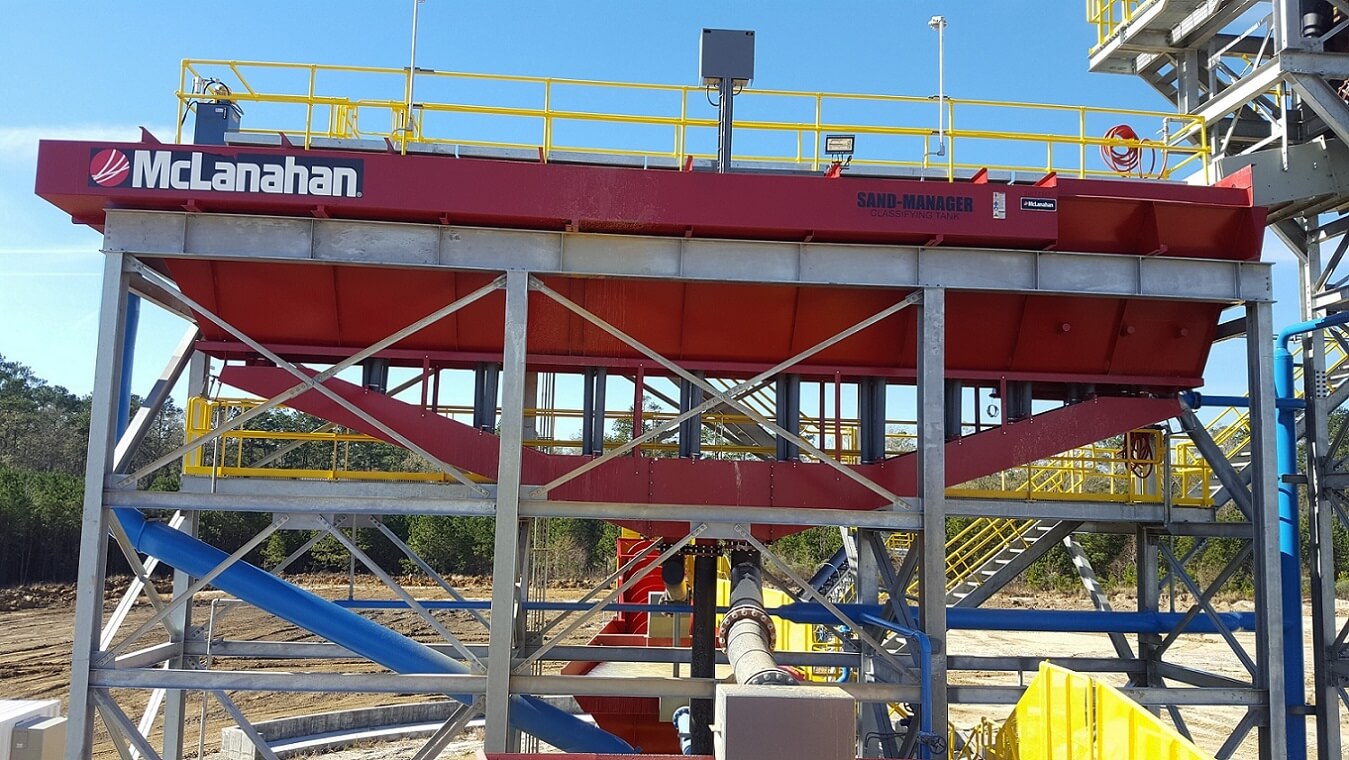Introduction
Sand Classifying Tanks are used by aggregate producers all over the world to remove excess water and create one or multiple specification products from a single feed.
The reason sand tanks (often referred to as water scalping tanks) are popular in the construction aggregates industry is because they can handle large amounts of water very efficiently.
Large volume sand slurry applications typically need an efficient and economical way to separate some water from the sand solids. There are a few ways to accomplish this, with Sand Classifying Tanks certainly being a viable option.
While sand tank underflow (discharge) is manageable at 30% to 50% solids, further dewatering is necessary. This can be accomplished with a Fine Material Screw Washer, or a process involving Dewatering Screens.
Although Fine Material Screw Washers have been a favored solution, Dewatering Screens are becoming widely accepted.

Fine Material Screw Washers
If you’ve washed sand at some point in your career, you’ve probably used a Fine Material Screw Washer.
Like sand tanks, sand screws are a staple in the construction aggregates industry. They have been used by producers for decades to wash, classify and provide a partial dewatering of fine aggregate material, and they are still popular to this day.
Sand screws are typically the equipment of choice for dewatering sand tank underflow because they are very forgiving. Sand tanks discharge at different rates, different percent solids and different volumes, and a screw washer can handle all those fluctuations quite well.
A Fine Material Screw Washer will accept whatever you feed it, and it will give you a product that can be immediately stockpiled and sold.
Screw washers provide additional dewatering of sand tank underflow, discharging a product that is around 20% moisture.
Underflow from the sand tank enters the washer box of the Fine Material Screw Washer, where it is met with a rising current of water to help float out unwanted fines. Product size sand settles to the bottom of the box and is conveyed up an inclined dry deck toward the discharge by a rotating screw shaft or shafts.
The material is dewatered as it travels up the incline and water flows back into the washer box.

Fine Material Screw Washers have been around for more than 60 years. They are simple, relatively inexpensive, widely accepted, and easy to install, and they can accept a varying feed rate.
Dewatering Screens
Dewatering Screen Plants or Ultra Sand Plants, which feature a combination of Hydrocyclone(s) and Dewatering Screen, are becoming more and more popular for dewatering sand tank underflow.
Even though this method is often recognized as new technology, Dewatering Screens have been handling sand tank underflow for nearly 20 years.
Traditionally, processes involving Dewatering Screens like to have consistent feeds, volumes and percent solids. This process using Dewatering Screens is designed to handle discharge fluctuations that a sand tank produces.
Sand tank underflow enters the feed box of the Dewatering Screen. Counter-rotating vibratory motors throw the material upward and forward along the screen surface toward the discharge. Water detaches from the material and exits through the holes in the screen’s surface.
Any fine particles that exit with the water are pumped to a scavenger process utilizing Hydrocyclones, ensuring no product losses and efficient dewatering.
This process proves to be highly efficient, while producing a consistent drip-free product with a moisture content in the 10-15% range.

Which is better for dewatering sand tank underflow?
Since Fine Material Screw Washers and Dewatering Screens are both acceptable processes for dewatering sand tank underflow, often the choice comes down to comfort level. Producers are very comfortable using screw washers, which provide an acceptable product.
A screw washer, though, can be very inefficient, and you may lose product size fines in the overflow. Dewatering Screens, on the other hand, are much more efficient, recovering product size fines while reducing displaced material to the waste stream.
Dewatering Screens produce a product that can be 5-10% drier than a product produced by a Fine Material Screw Washer. While this may not seem like a major difference, the drier product makes for improved material handling and quicker sale.
Also, by removing the additional 5-10% moisture, the Dewatering Screen will save millions of gallons of water each year over a screw washer.
Although they have a higher up-front cost, Dewatering Screens use less power and have fewer wear parts than Fine Material Screw Washers, so they are less costly to operate and maintain.
While screws are favored for dewatering sand tank underflow, there are some instances where it makes sense to use a Dewatering Screen over a sand screw.
The producer has to look at the value the Dewatering Screen brings to them in terms of a drier product and less equipment maintenance. The more information you can provide your supplier, the better they can make an appropriate recommendation.









